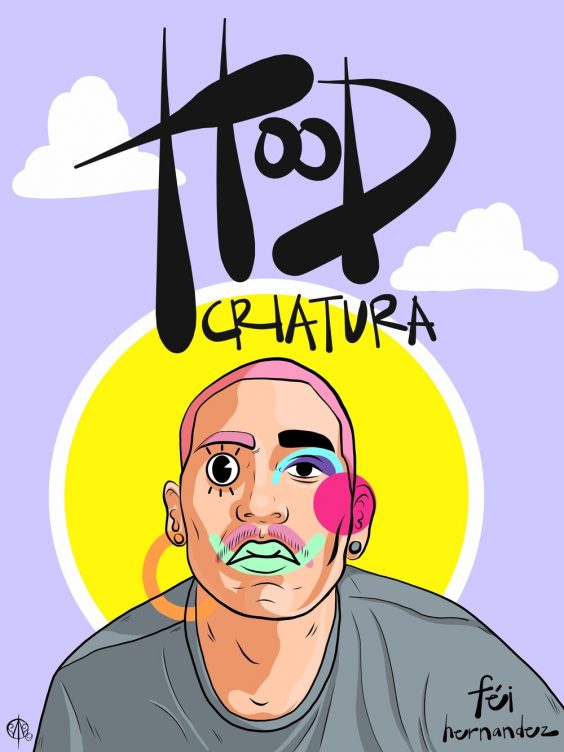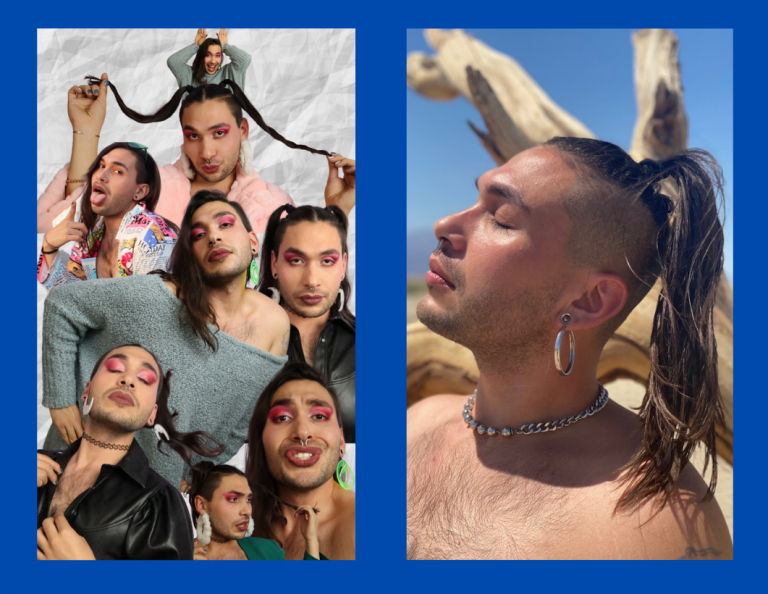Over the years, féi hernandez has learned how to channel their magic into the art ofbecoming Hood Criatura: a beautiful beast — half magic, half person. Through their breakthrough poetry collection, Hood Criatura, féi hernandez illustrates their experiences as a queer, trans, and immigrant adolescent. hernandez describes their debut collection of poetry as the kind of resource they longed for growing up; through poetry, it directs readers to discovering a home where they have the support to begin their own revolution — one of self-acceptance and self-love.
In the month of January, hernandez performed in City of Asylum’s ongoing Latinx & Proud! Series — and afterwards, they were kind enough to join Sampsonia Way for a conversation about their work as a poet, healer, and mentor. (For more work by féi hernandez visit https://linktr.ee/feihernandez)
Becoming Hood Criatura?
I loved how complex Hood Criatura was. It was so diverse and unique that I almost didn’t know where to begin when I was writing questions. I was curious, though, what was your goal when you started this book?
I didn’t have a sense of what this book was going to be when I went into it, but the goal was to put together this beautiful beast out of all my broken pieces. I wanted to be able to read a book that represented the experiences that I went through that I hadn’t read or seen before. I wanted to leave something of substance behind that could be used as a resource, a mirror, or anything else it needs to be for folks like me, folks in my community, my people — known and unknown.

How has your work as a Healer affected your writing?
As a child, I was really sensitive to the energies around me. Magic came easily to me. I have these, what we call, dones, which are gifts that you’re just born with.
I think my sensibility to see and to hear things far beyond the scope of just the 3D world, or the day-to-day, helped me view the world more expansively. It almost, like, activated everything, including the mundane. But it took time before I was able to channel my magic into the healing work I was brought here to do. It mostly manifested through my art, my writings, and organizing work at the start. Now, I work directly with the community and do collective grief and ancestral healing work.
Inspiration
Where did you find your sense of belonging? Is there any particular piece of literature, or even a person who really accepted you and helped you understand yourself better?
I would say that Natalie Diaz’s work really helped me find a home, not only in content, but in the expression of it — the more technical aspects of writing. I was moved because I realized they were capable of weaving such complicated themes, traumas, hurt, legacies and histories into literature, and they were really good at it! So, I realized there was a way to do this too, and I had to try it for myself.
Have your had other mentors or guides along your journey, too?
As for a mentor, I would have to say Patricia Smith. I worked with her when I got into the Voices of Our Nations Arts Foundation in 2017. That was the first time I uttered the words, my father doesn’t know I’m his daughter, too, through a poem. And that was literally the basis for Hood Criatura. That was my first moment naming what I’ve always been: trans.
Patricia changed everything for me. She made me feel like I belonged and I existed even within my limited comprehension of scope in the grand scheme of the literary world. She saw the fire in me and that gave me the permission I always needed to unleash my power. I also learned a lot of technical skills from her, my favorite one being enjambment. My manuscript is alive thanks to Patricia Smith and my lovely cohort, the Throat Queens. I have so much gratitude for my mama and my siblings who changed my life forever.
Activism and Beyond
I was also curious about your teaching career. I was wondering if you could talk a little bit about your experience and what it was like to see kids starting their own revolutions?
My three years of teaching were some of the most meaningful years of my life. I was out as trans, and went by the honorific “Mx.” And it was definitely a learning experience for many, but a lighthouse for others. To say that revolution happened in the classroom is to downplay the powerful transformations we all underwent — we definitely conjured an essence of the new world.
We grew collectively, activating our spirits through art and creative writing, from writing letters to the folks protesting against the North Dakota pipeline (#NoDAPL), to creating welcome sign placards to refugees from Central America and other places at the Mexican-American border. We learned to love, to understand our context and positionalities, to confront our privileges, and to learn to respect each other for our differences.
How did you bring activism into the classroom?
I did a unit on making logos and sticker designs. And then I showed them how to make stickers and laminate their work so they could see just how applicable that could be in real life for them. They could sell their own original and laminated bookmarks, sell their stickers, make logos for their business, and use social media like Instagram to showcase their products. I loved seeing the fire in their eyes — the conviction and passion.
I also did a book club with immigrant moms (mothers of the students I taught) where we read books in Spanish! It was amazing to see my own mother in the migrant moms I worked with and give back directly to them. We had a place of our own where they read books they wanted to and had the space to talk about their lives and how it related to the stories we read.
It was really fulfilling to see them engage and start seeing themselves as part of something larger rather than just a parent dropping their kids off at school. Instead we activated in each other a sense of being, “part of a community.” And deconstructed “what does that mean?” for ourselves, each other, the school, and our children/students.
I noticed there was a common theme of referencing Catholicism. I was curious if Hood Criatura was meant to kind of represent a Bible for those who feel ostracized because of their identity?
I grew up in a very spiritual, specifically Catholic, family. The way my family honored different saints and angels allowed me to see the many parts of divinity. In Hood Criatura, there are a lot of references to the Bible because no matter how spiritual we were or how religiously estranged we were, the Bible was still a reference point of comfort although we know it’s long trajectory of violence. When things would go astray, my mom would grab the Bible and turn to a random page and read whatever Bible verse she landed on. We both don’t know many bible stories, we’ve both never read the whole damn thing, but we do know that in the darkest of times there was a book, the Bible, open in a corner of our home that gave light to our hearts no matter how dark it was.
To be honest, I don’t think I went into writing Hood Criatura with the intention of it being a Bible, a monolith reference guide to all people that are trans, or Mexican, or who grew up in Inglewood. I am only one perspective, one life, and can not speak for others. However, what it could be is some light in moments of hardships. Maybe fragments of my life can help others see specific fragments of their own lives — that’s why I write.
I’ve always imagined a younger version of myself, younger versions of my people at a bookstore not knowing what to get. And there it is: Hood Criatura on display. They turn to a random page and read a stanza aloud. Maybe they feel seen as an immigrant, they feel seen as a trans person, as a queer person, as a displaced person who’s been abandoned, but who has discovered so much in the process.
At that moment, they understand their potential. Like Natalie Diaz did for me, I hope to encourage others to find ways to weave their own blankets, to tell their own stories. We all have so much to contribute. So many stories are still buried due to systemic inequities.
I write to crack the earth and say: we are here and our stories are bountiful and necessary — just look at us, we’re beautiful.


